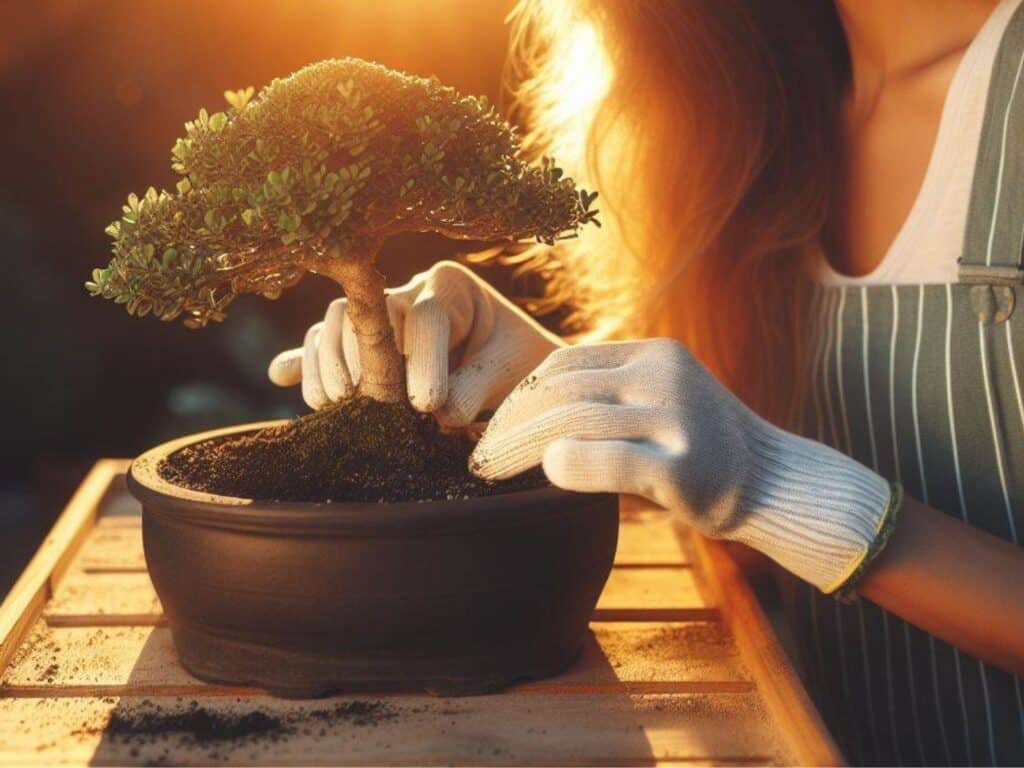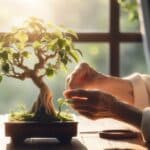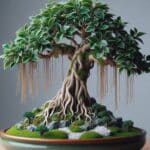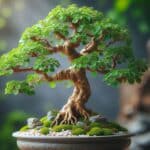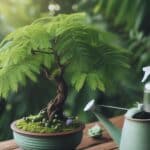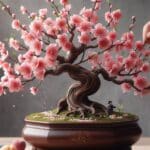It can be tempting to use normal potting or garden soil when attempting to grow a bonsai tree for the first time. However, using these common soil types is one of the biggest mistakes bonsai beginners can make.
These normal container soil types tend to harden over time. When this happens, it can restrict root development or cause water retention, resulting in root rot for your little tree, and the thick, heavy soil doesn’t contain enough oxygen to support healthy growth.
If you want your bonsai tree to grow healthy and strong, then using a proper bonsai soil mix is best. In this guide, we will discuss what this soil mixture is. We will show you how to make your bonsai soil and discuss the best bonsai soil mixes for different types of trees.
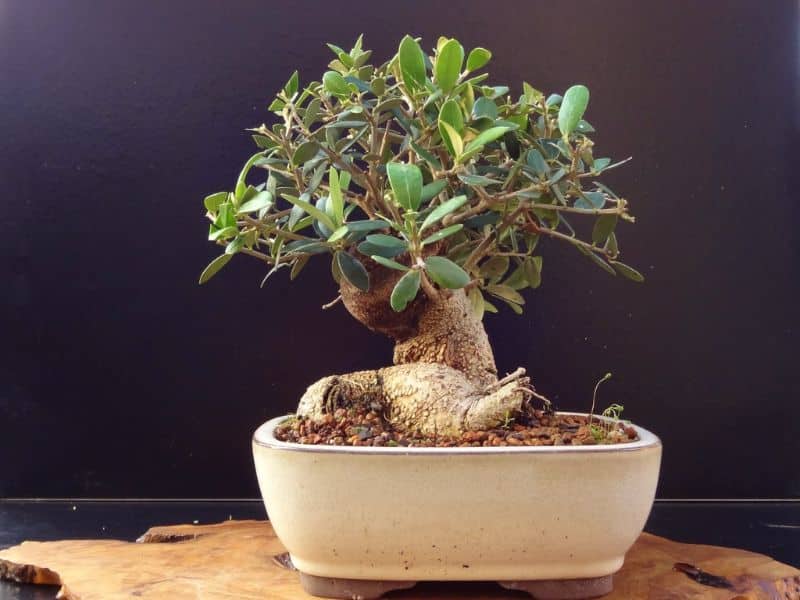
What is Bonsai Soil?
Bonsai soil is the growing medium in which your little tree is planted when you position it inside a bonsai pot. This type of growing medium anchors the plant to the container, it supplies your tree with valuable nutrients and holds water so the root system can flourish.
Bonsai tree soil differs from your average garden or potting soil because this type of soil is specially formulated to hold a higher percentage level of water and air by volume.
Typical garden soil usually consists of 50% soil, 25% water, and 25% air by volume. This type of soil is too dense and will harden over time, making it hard for your tree to get enough water and air to develop well.
Bonsai soil, on the other hand, contains more air pockets and can absorb a lot more moisture. These soils also have less soil and some mixtures don’t contain any actual soil. Growers use substrates instead of soil to create a more suitable growing medium.
Plenty of different substrates can be used to create bonsai soil mixtures. Some of the main ingredients for these soil mixtures include organic materials like compost and bark or inorganic materials like grit, clay, and rock.

What Soil is Best for Bonsai Trees?
Many different bonsai tree soil types exist because other plant species have different nutritional and moisture needs.
Suppose you are still deciding what soil to use. In that case, it is best to use a basic bonsai mixture consisting of ingredients like Akademia, pumice, lava rock, and organic potting compost.
If you want to give your tree the best possible care, then it is usually best to purchase a soil mixture that is designed for your specific tree species or to create your bonsai soil by mixing in various components that will help you create a soil type that will offer your tree the most benefits.
Common Components Used for Bonsai Tree Soil

Bonsai tree soil can be made from a wide range of components and they usually consist of organic and inorganic materials. Here is a quick look at some of the most common ingredients or components for these types of soils.
Inorganic Components
Inorganic components are porous substrates that don’t break down easily. These substrates usually have a larger particle size and are very functional for enhancing drainage and aerating the tree’s root system.
Pure inorganic soil isn’t suitable for growing bonsai because these components don’t absorb water or nutrients. However, they enhance drainage and aeration to keep your tree from developing root problems.
Here is a quick look at some inorganic components used in bonsai tree soil.
Grit
Grit is a type of fine gravel and it is one of the most common substrates for container plants. The particle size of grit can vary for different bonsai mixtures. The most common sizes range from 4mm – 8mm in diameter and are ideal for enhancing drainage and aeration.
Perlite
Perlite is a type of volcanic glass mined and produced at 1600 degrees F. This type of substrate is more porous with large particles and is light in weight and white in color. It is ideal for creating a lighter soil mixture for larger trees since these particles can keep containers lighter, reduce density around root systems, and aerate the tree.
Surface
Turface is calcined clay that is produced at 1500 degrees F. This type of substrate has large particles which helps enhance drainage but the particles are more porous which also helps retain water.
Pumice
Pumice is a type of light volcanic rock that can boost drainage and aeration and, because the rock is porous, it retains water so soil can stay moist for longer. The substrates have rather large particle sizes of about 1/16 – 7/16 inches in diameter.
Akadama
Akadama is one of the most common substrates used in bonsai mixtures. It is a type of Japanese clay that can enhance drainage but retains water well.
While this can be an excellent soil component, it does break down after two years, after which you will need to replace the soil. It is also important to sift the akadama before using it as soil components because smaller particles can clog up the drainage holes of your containers.
Rice Rock
Rice rock is also known as limestone pea rock. This type of crushed limestone aggregate usually has 1/4-inch particles, a good product for enhancing drainage and aeration. Limestone is also naturally porous and will absorb water, which can improve your soil water retention.
Lava Rock
Lava rock is made from volcanic rock and is a popular inorganic component in the bonsai soil mix. This type of product is very porous, absorbing a lot of water.
Unlike pomice and akademia, this product doesn’t break down easily and it can enhance aeration and drainage. It is ideal for slow-growing trees that require infrequent repotting.
Vermiculite
This hydrous phyllosilicate mineral is heated to expand the particles so the mineral can retain water and oxygen. The particles are gray to sandy brown and can be good for aerating the soil while enhancing water retention.
Organic Components
Organic components refer to the substrates inside the soil that come from natural resources. These components usually contain lots of nutrients and minerals and can greatly boost trees. Organic matter tends to break down easily and should be replaced every few years.
When these components start to break down, they can also clog up drainage holes or create a more solid soil constitution, making it hard for the soil to drain properly. Here is a quick look at some common organic components used in bonsai tree soil mixtures.
Rice Hulls
Rice hulls are the protective coatings found around unprocessed rice grains and are great for enhancing water retention of your soil mixture because they can absorb a lot of moisture. The air pockets in these hulls can also aerate your plant and can have good drainage qualities.
Pine Bark
Pine bark is a type of organic component that is made from the bark of pine trees. Some organic pine bark substrates are processed to enhance their durability. The product is good for enhancing drainage and aeration.
Peat Moss
Peat moss is often used in garden potting soil and looks like potting soil mixes. This product type is also known as hummus and is made from peat bogs. Peat moss is great for retaining moisture and for enhancing drainage. It is a good product to use in dryer climates because it can keep the soil cool and moist for longer.
Organic potting compost
Organic potting compost is a mixture of peat moss, perlite, and sand. This mixture of ingredients can retain too much water, offer too little aeration, and might make it difficult for the soil to drain well. However, it can work well as part of your bonsai mixture if you add inorganic materials.
Best Soil Mixes for Bonsai Trees

Bonsai soils consist of a mixture of organic and inorganic materials. These “ingredients” can vary a lot in order to accommodate the different growing requirements of different bonsai tree species.
Some tree species might require more consistently moist soil, while other plants prefer dryer conditions. Even though some trees prefer more moisture, all bonsai trees should be planted in soil that drains well.
Let’s look at the different bonsai tree soil types for different tree varieties.
Bonsai Soil Mix for Succulent Bonsai Trees
Succulents require less water which means that you should have a soil mix that drains very well. For these types of trees, you can use a simple succulent potting soil mix. These types of mixes usually have the following ratio.
- 2 Parts sand
- 2 Parts gardening soil
- 1 Part Perlite or pumice
Bonsai Soil Mixes for Tropical Plants
Tropical bonsai tree species like ficus or Fukien trees require more water and usually don’t grow well if the root ball or root hairs dry out too much. These plants prefer soils that hold more moisture but they should still drain well and they need lots of nutrients. Here is a quick look at a suitable soil ratio.
- 40% Akadama
- 33.3% Pumice
- 30% Organic Materials
Bonsai Soil Mix for Deciduous Trees
Deciduous bonsai trees like elms, maples, and ginkos usually become dormant during winter. They shed their leaves during winter and typically don’t like a lot of water during winter time. These types of soil mixes usually have the following ratio.
- 50% Akadama
- 25% Pumice
- 25% Lava Rock
Coniferous and Pine Soil Mixtes
Coniferous trees like cedar, junipers, and pine trees typically become dormant for the winter and they can tolerate dryer soil types. They flourish in soil with good drainage and don’t retain too much moisture.
- 33% Akadama
- 33% Pumice
- 33% Lava rock
How to Mix Your Own Bonsai Soil
A lot of bonsai artists recommend creating your own bonsai soil mixtures because it will make it much easier to create a soil type that matches your tree perfectly.
It can be difficult to find the right balance of elements for your trees, especially since different tree species have different moisture and nutritional needs and because your living environment can also impact the type of soil you should be using. Here are the steps for creating your own bonsai tree soil.
- Find out what your tree’s needs are and purchase suitable components. A good quality soil will contain at least three main bonsai components.
- Add a suitable ratio of soil components to a container and mix these components thoroughly.
- If the container has large drainage holes then it is best to layer the container with some mesh. This will keep the soil from flushing out of your bonsai container.
- Before you add the bonsai tree soil to the container, you should add a layer of gravel inside the container. This layer of gravel will keep the drainage holes from becoming clogged up and can enhance drainage so your tree won’t become waterlogged.
- Next, you can add your freshly mixed bonsai tree soil to the bonsai pot. Add a little bit of soil before you plant your tree inside the container and cover all the roots with some more soil. Press the soil down on the root system to remove unnecessary air bubbles or air pockets.
Conclusion
There are many different bonsai tree soil mixes because trees vary so much in terms of nutritional and moisture needs. If you want to grow a healthy and strong tree then it is best to always do some research about your tree species and to find out what its growing needs are.
If you are in a pinch then it is best to simply buy some pre-made bonsai soil mixes from a local nursery. These mixes usually consist of a good ratio of organic and inorganic matter and most tree species should be able to grow relatively well in it.
Do some research about your tree in the meantime so you can purchase a more suitable soil mixture before your next repotting session. With the right soil, your tree will show lots of healthy growth and your overall maintenance will be reduced since the soil will naturally maintain a better moisture and nutritional balance for the tree.
Up next: How Often to Water Bonsai

